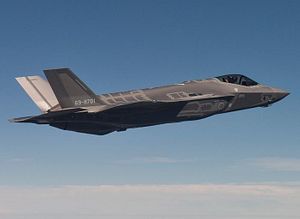The Japan Air Self-Defense Force (JASDF) said on June 10 that pilot vertigo was the likely cause of one its fifth-generation Lockheed Martin Lightning II F-35A Joint Strike Fighters crashing into the Pacific Ocean off northern Japan more than two months ago.
A JASDF report notes that the aircraft’s pilot, 41-year old Major Akinori Hosomi of the service’s 3rd Air Wing’s 302nd Tactical Fighter Squadron, most likely suffered from “spatial disorientation” during a training mission on April 9.
“We believe it highly likely the pilot was suffering from vertigo or spatial disorientation and wasn’t aware of his condition,” Japan’s Defense Minister Takeshi Iwaya said on Monday when presenting the JASDF report.
One definition of spatial disorientation is “the inability of a pilot to correctly interpret aircraft attitude, altitude or airspeed in relation to the Earth or other points of reference.”
Parts of the F-35As heavily damaged flight data recorder were recovered last month. However, the recent JASDF reports relies solely relies on pilots’ testimonies and data and communication received by ground controllers.
Notably, the report dismisses mechanical defects or software problems as the cause of the crash. The JASDF also notes that as a result of the crash its F-35A pilots will undergo additional vertigo training.
The JASDF’s entire F-35A fleet remains grounded for the time being. This includes the 14th F-35A, assembled at the Mitsubishi Heavy Industries (MHI) F-35 Final Assembly and Check Out (FACO) facility in Nagoya.
According to the JASDF, flight operations will only resume following a thorough technical checkup of all remaining F-35As and a meeting with Japanese residents living near Misawa Air Base in Misawa, in Aomori prefecture in the northern part of Japan’s main island of Honshu.
Major Hosomi’s F-35A disappeared from radar tracking systems at 7:27 p.m. on April 9 about 135 km (84 miles) east of Misawa Air Base. His aircraft was one of four F-35As that took off from Misawa Air Base for a training mission at 6:59 p.m., Japan time, on that day. According to the JASDF, Hosomi engaged in aerial combat training and shot down two enemy aircraft in a simulated dogfight.
His last message was transmitted in a “calm voice,” the JASDF notes in its report. A few seconds after the pilot’s last message was received his aircraft crashed into the Pacific Ocean at more than 1,100 kilometers per hour (683 miles per hour) with no reported attempt by Hosomi to avoid a collision.
There was no evidence that the pilot managed to eject before impact. Major Hosomi was officially declared dead on June 7.

































